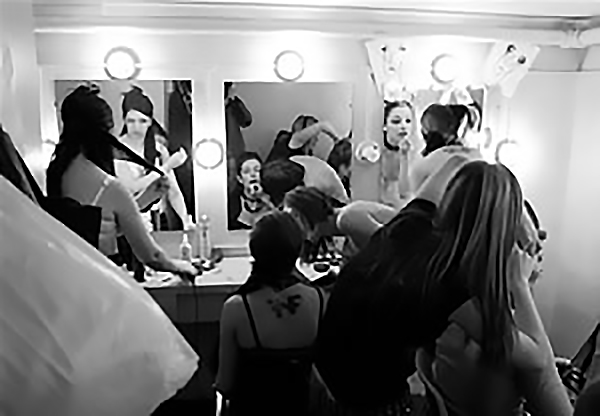“Pulling an all-nighter” is a quintessential university experience. But harried-looking students flipping through textbooks or staring bug-eyed at their computers at daybreak are only part of the story. U of T bustles with activity after dark. Tag along as we pull an all-nighter of our own (well, three actually), to explore the nooks and crannies of a campus that never sleeps.
10:52 p.m.
There aren’t any cheering crowds – just the fluorescent glow of the ice and the thrum of the Zamboni as captain Michael Georgas gears up his team to hit the ice at Varsity Arena.
This is how most intramural hockey is played at U of T: late at night with few spectators. Tonight, the engineering hockey team, the Skuleyard Bullies, is taking on U of T Scarborough. The game is played for fun, not glory.
“I love hockey,” says Damien Frost, a third-year engineering student and the Bullies’ right defenceman. “It’s great to play in an intramural setting because you know most of the people on your team. It’s like playing with your buddies.”
Georgas sends out his players to warm up with some passing and shooting drills. “Our players are from all different years,” he says. “It’s a way to get people together.”
Each year, about 8,500 students play intramural sports, participating in everything from triathlons to table tennis. While some of the teams play at a varsity level, there are divisions for all types and abilities – inner-tube water polo, for instance, for students who need help staying above the water-line.
Anne Richards, one of the nine sleepy-looking spectators in the stands, is here to see her son Mark skate for the engineers. “The teams only play five games in a semester, so if you miss one, you’ve missed a lot of the season,” she says. The late start time is fine with Richards: “It’s more convenient, actually,” she says, eyes on the ice. “This way, it doesn’t conflict with anything except sleep.”
11:44 p.m.
“The Rocky Horror Show is a midnight kind of experience,” says Jenna Rocca, batting her fake eyelashes and adjusting her bowler hat. Rocca and her friend Bill Hulme have taken front-row seats at Hart House Theatre for UC Follies’ production of the cult classic, and they’ve dressed for the occasion. Rocca has chosen to wear a black bra as a shirt, and Hulme has smeared gold glitter on his bare chest. Rocca is what Rocky Horror veterans call a “virgin”: it’s her first time seeing a theatre production of the campy rock opera. “But I’ve seen it at least six times on video,” she says.
Rocky Horror is the raunchy tale of a transvestite alien, Dr. Frank N. Furter, who seduces an innocent couple, Brad and Janet, at his secluded mansion.
While the Hart House Theatre crew are resetting the stage for the midnight premiere, cast members speak about rehearsing for the notorious musical.
“It’s like no show you’ve ever been in,” says Peter Jermyn, who plays Rocky, the doomed title character. Flesh-baring costumes heighten the racy vibe – Jermyn wears little more than a shiny jockstrap. Not surprisingly, rehearsals centred on getting the actors comfortable with the revealing outfits. “We had to become, um, familiar with each other,” says Claire Burns, who plays Columbia, one of Furter’s “assistants.”
The hard work has paid off: tonight’s show is one of four sold-out performances.
“It’s almost midnight!” gasps Burns, checking her watch. “All the crazies are going to come out!”
12:28 a.m.
Fiona Rankin studies a set of graphs scrolling across her computer screen in the sleep laboratory at the Toronto Rehabilitation Institute on University Avenue. The graphs measure the breathing patterns, heart rates and brain waves of three patients. Rankin points to a long flat section in one graph. “This man essentially stopped breathing for a full minute,” she says.
Rankin, a technician, is working three 12-hour shifts this week. Most patients at Sleep Research Laboratory have sleep apnea, a condition that can cause them to temporarily stop breathing dozens of times a night. Heavy snoring is one indicator of apnea. In Rankin’s office, three Fisher-Price baby monitors, one for each patient, emit a gentle rumble.
“Did you hear that?” Rankin asks. “He started breathing again after 81 seconds. That’s a very long apnea.”
Dr. Douglas Bradley, a U of T professor and the laboratory director, is investigating how sleep disorders relate to cardiovascular problems. In a recent study, Bradley and his research team found a link between sleep apnea and the risk of stroke.
As for Rankin, she says that the rewards of assisting with this type of research are high, but admits that working at night takes a toll. “I have a lousy sleeping pattern,” she says.
1:07 a.m.
“In this lab, we study nematode worms,” says Mariam Alexander, a second-year master’s student in medical genetics. She and Alexandra Byrne, a third-year PhD candidate in medical genetics, are using the tiny worms to determine how specific genes affect muscle development and also how genes work together in the context of a whole animal.
Their lab is on the 12th floor of the sleek new Terrence Donnelly Centre for Cellular and Biomolecular Research, which offers a shimmery, nighttime view of downtown Toronto through its floor-to-ceiling windows. On any given night, you’ll find a handful of masters and PhD students in this lab, completing experiments, crunching data and compiling results.
“The worms have a three-day life cycle,” explains Byrne, so for students engaged in a complex experiment, that means working to the worm’s schedule.
“It’s a biological organism,” says Alexander, “so it’s not like we can turn it off and come back and continue the experiment. The worm will die, and then you lose everything.”
Byrne and Alexander, who have been working in the same lab for about two years, say the new Donnelly Centre labs are a vast improvement over the windowless rooms of the Medical Sciences Building, where they used to conduct research. “Here you can see the sun rise and set,” says Alexander, “There’s actually daylight.”
2:16 a.m.
“This is why we don’t have any glue sticks left,” sighs Claudia Calabro, reaching up to pull an errant tube of hardened glue off the ceiling where an anonymous prankster has stuck it. Calabro is the editor of the Gargoyle, University College’s irreverent, often satirical and sometimes plainly juvenile newspaper. Tonight the paper’s staff is working on its election issue.
Part of the Gargoyle’s enduring appeal is its grungy, handmade look, which comes from assembling it the old fashioned way – by cutting out pictures and text with X-Acto knives and gluing them onto large sheets of paper. About a dozen student staffers are gathered around the conference table – an abused billiards table, with the snooker balls lumped in the pockets – to survey the layout.
“We can’t tell this joke,” says someone at the far end of the table, arguing that it’s too tasteless, even by the paper’s risqué standards. An editor quickly renders the one-liner unreadable by crossing it out with a thick black Magic Marker.
“There are still four pages left to do,” Calabro hollers from her desk, where she’s writing her editorial. “We have to get everything done in half an hour or it won’t be printed tonight.”
Thirty minutes later, the edition is edited and glued down. Calabro shouts a victorious, “Somebody call a taxi!” The students clear the billiards table and bundle up the pages. Calabro and company head out into the cold and assemble on the front lawn of University College to see their baby into the cab that will rush it to the printer.

3:24 a.m.
In a reading room at the Robarts Library, the students look either bored, desperate or deep in concentration. Several are completely unconscious.
Mai-Ling Truong, Joey Ng and Katherine Elton* are staked out at a table in the main lobby. They all have looming deadlines.
“I’m working on an essay on the Indian Act,” says Truong, a second-year Aboriginal studies student. “It was due today.”
Ng, a fourth-year life sciences student, is writing a book report about Filipino culture on the Internet. “It’s one of the most boring topics ever,” she groans.
Elton, a third-year political science student, is supposed to be writing about Quebec separatism for an essay that was due two days ago. “My enthusiasm is unparalleled,” she says, rolling her eyes.
The three are no strangers to late-night work, although Elton says that the frequency of their midnight study marathons varies. “Sometimes I don’t work late at night at all and sometimes five nights in a row.” It may not be for everyone, but it’s a system, says Elton, her friends typing furiously beside her. “We don’t usually wake up until 1 p.m., so this is our time.
4:05 a.m.
In the deepest reaches of the McLennan Physics Building on St. George Street is a room that’s crucially important to every student, and staff and faculty member – though few have ever seen it. Stored in this heavily air-conditioned bunker are the e-mail servers, payroll mainframes, Cray supercomputers and hundreds of other blinking, whirring and buzzing computers.
Network Operations (as it’s called) is like Grand Central Station, and it’s Sam Harrichand’s job as a shift supervisor to keep the trains running.
“See that red light?” asks Harrichand, pointing to a blip on one of the five monitors that indicate network traffic. “That’s someone launching an attack.” The hacker, location unknown, can’t find a chink in U of T’s armour. But other hacks have broken through.
“If the network goes down or the mail servers fail, I have to wake people up in the middle of the night to fix it,” he says. While such hacker attacks present a serious inconvenience, Harrichand says they make his job interesting. “I have to act quickly to get the network back in working order,” he says.
Harrichand blocks about a dozen attacks during a 12-hour shift, but the threats are mostly minor. “I like the work,” he says. “It’s quiet.”
6:01 a.m.
It’s windy and well below freezing, but in the attic at 91 St. George St., Jahmin Haye and Ricky “Turbo” Brown are heating up the airwaves with the rhythms of the Caribbean. Their radio show, The Morning Ride, is a mix of reggae and dancehall. Every Monday, it broadcasts live from 6 to 9 a.m. out of U of T’s community radio station, CIUT 89.5 FM. But today is no ordinary Monday: It’s Bob Marley’s birthday, and they’re dedicating a whole show to the music of the reggae legend.
“Today is going to be an extra-special celebration,” says Brown, introducing the show. “We’re celebrating the life of Robert Nesta Marley, born February 6, 1945, part of the Jamaican group the Wailers.”
CIUT’s signal has the largest broadcast reach of any campus radio station in Ontario. Today’s first caller, from Buffalo, requests “Could You Be Loved,” saying it’s his favourite Marley track.
“The Morning Ride” is consistently one of CIUT’s most popular shows, reflecting both the size of the Jamaican community in Toronto and the appetite for reggae generally. “You can’t stop the music, man,” says Brown. Haye nods in agreement.
After doing “The Morning Ride” for nine years, they still find getting up at 5 a.m. a little hard to take, but they’re dedicated. “It’s love, man, just a passion for the music,” says Haye. “It’s still not like a job because it’s …” he turns to Brown and asks, “What’s the word I’m looking for? It’s a responsibility.”
And with that, the red On Air light is back on. Duty calls.
6:25 a.m.
Through the windows of the Athletic Centre, the sky is a strip of dingy grey. Members of U of T’s swim team are wandering onto the deck of the pool for morning practice. Every sound in the humid, chlorinated air echoes sharply, yet it’s surprisingly quiet – just the sound of flip-flops on tile as the team members yawn, stretch, and get the kinks out before plunging in.
“I swim all five weekday morn-ings at 6:15, a little later on weekend mornings and then three nights a week,” says first-year student Hannah-Jo Ryan. “But if there was no coach on deck, I would have a tough time getting in this early.”
Each morning, the team spends two hours swimming laps and doing exercises to build strength and endurance and to improve their technique. For second-year student Marco Monaco, the training has paid dividends: he recently took silver and bronze medals in the breast-stroke at the Canadian Interuniversity Sport championships in Quebec City. The U of T men’s swim team placed third in all of Canada.
Such success requires exceptional dedication. “We train an extra half-hour a day just to take off tenths of a second,” says coach Byron Macdonald. “Marco happens to be one of the more intense trainers on the team.
“It’s the will to win,” says Monaco. “Getting up so early and having classes all day gets you really tired. But it all comes with what you do.”
The concentrated training schedule separates varsity athletes from other students. “You can’t really be like other people,” says Ryan. “A lot of my friends will stay up until 4 a.m., sleep through classes, and get up and do it all again. I can’t do that.”
The crack-of-dawn practices bring their own rewards, though. “If you start the day off with a really good workout, you feel great,” she says. “You feel like you’ve already accomplished something.”
7:55 a.m.
Pat Cave is now working days as a portress at St. Hilda’s College. But she has seen an awful lot of night shifts since beginning her career at the Trinity College women’s residence 40 years ago. “When I started working here, a young woman who wanted to be out after midnight had to go to the don and request a ‘late night out,’ and sign the book,” says Cave. “Then the don would give her a key.” Now the residents – both men and women – have their own floor keys. And there’s no one keeping a log of their nightly comings and goings.
In the 1960s and ‘70s, the women who lived at St. Hilda’s weren’t permitted men in their rooms, except on weekends. Weekday visits were restricted to “the pink room” – a large room on the first floor, where several visits often took place simultaneously.
Cave, who came to Canada from Guyana in 1964, worked as a cook for two years before starting at St. Hilda’s. Cave figures that she met thousands of students during her career – and got to know surprisingly many of them. “Some of the girls that live here now, their mothers were here,” she says. In February, Cave received a card from someone who had heard that she’ll be retiring in June.
With another shift beginning, and visitors coming and going under Cave’s watchful eye, she says she’s ready for retirement. But Cave intends to come back to visit. “Whenever I’m downtown, I can just drop in on St. Hilda’s and make sure it’s all in working order.”
*Katherine Elton is a pseudonym
Recent Posts
U of T’s 197th Birthday Quiz
Test your knowledge of all things U of T in honour of the university’s 197th anniversary on March 15!
Are Cold Plunges Good for You?
Research suggests they are, in three ways
Work Has Changed. So Have the Qualities of Good Leadership
Rapid shifts in everything from technology to employee expectations are pressuring leaders to constantly adapt






